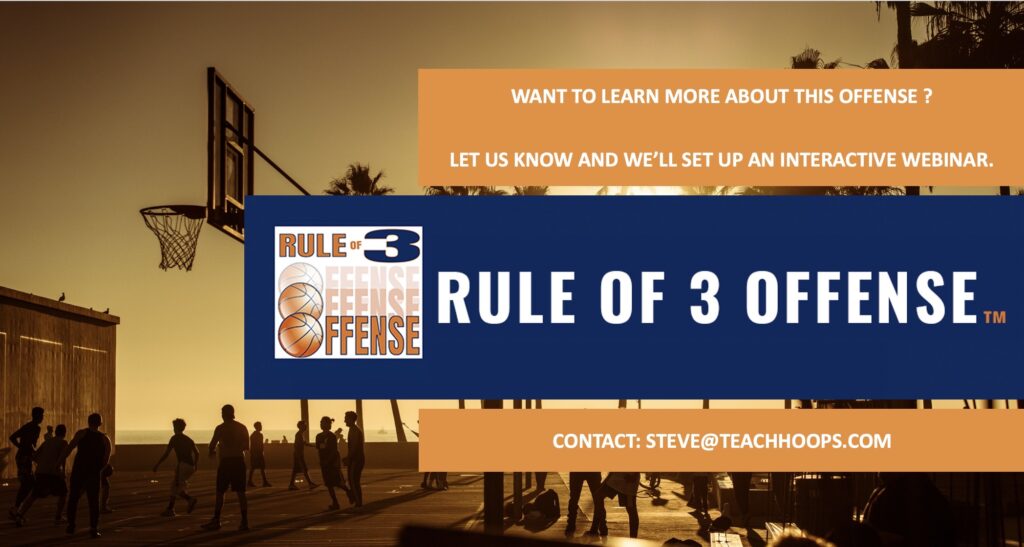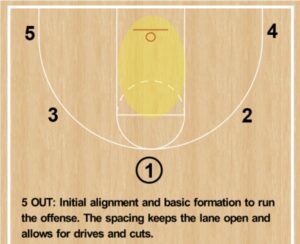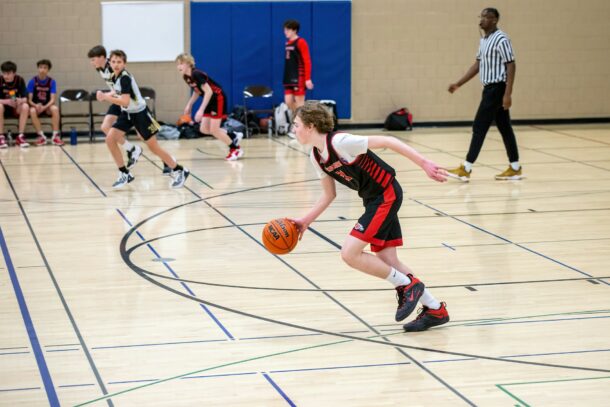The Rule of 3 basketball offense provides coaches with a concise offensive set up to help your team succeed. This offensive approach works against man and zone defenses and makes operating on that side of the floor easier. Some continuity offenses can be difficult to digest, but the Rule of Three basketball offense remains clear with straightforward principles. A key point of emphasis for this basketball offense is 5-Out Motion
What the Rule of 3 offense does for a basketball coach is provide a pared down approach that highlights the strengths of a given team. The key to any good offense is finding the openings, and this does just that. This offense remains predicated on ball movement, player movement, and spacing to create scoring opportunities.

5-Out Motion for the Rule of 3 Basketball Offense
 For the Rule of 3 basketball offense, using 5-Out motion often provides the most space for your team.
For the Rule of 3 basketball offense, using 5-Out motion often provides the most space for your team.
The term “5-Out” references the fact that all offensive players on the floor are starting outside the three-point line. Typically, the setup features one player at the top, two on the wings, and two in the corners.
The 5 Out alignment is the base for the Rule of 3 offense. All five positions are interchangeable but can be set up to match locations with player skills.
This “position-less” offense relies on floor spacing and a set of basic movement that assist players to determine actions.
The basic concept for 5-Out Motion features an easy-to-understand set up: cut and replace. Each of the five spaces along the perimeter should be occupied by an offensive player.
When one player cuts, his teammates shift along the perimeter in corresponding fashion. If too many players end up on one side, the coach could call to “balance the floor” from the sideline.

A good way to start teaching 5-Out Motion on a pass is to have the passer cut to the basket with everyone rotating to replace the open slot. The only exception to this rule is a pass from the corner.
5-Out Motion: Pass and Cut Drill
5-out motion provides basketball teams at any level a key structure. This is especially true for youth basketball teams. This set up forces players to make decisions by reading the play of their teammates and defenders. It remains a great tool for teaching players how to play basketball.
One drill to teach basic 5-Out motion to your basketball team is a simple pass-and-cut drill.

This drill begins with Player 1 making a pass to the wing. From there, that player cuts to the basket. When that cut occurs, everyone behind the pass rotates to fill the open space along the perimeter. Player 1 takes the open space in the corner after his cut.
Next, the ball is passed to the right again and the passer cuts to the basket. Once again, the weak side players rotate to fill all open spots. The only exception to this rule is a pass from the corner. A pass from the corner results in a short cut and retreat. A pass up from the wing to the top results in the corner player rotating up to fill on the wing, making sure all five players participate in station movement.
Stress to your players the key concept of great spacing. If they’re in the right positions at the right time, the offense should be wide open. This approach opens driving lanes and minimizes quick help from opposing defenders.
Coaches can teach 5-Out Motion in progressions to avoid their players getting overwhelmed learning an entire offense all at once.





